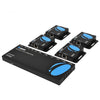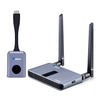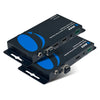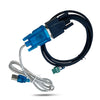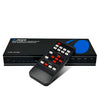
Finding out the best display resolution for your setup is becoming more and more confusing. With higher resolutions being introduced in the market, and some even going as high as 16K at 120Hz, the decision in choosing the best one may be a bit tricky.
In this article, we’ll be focusing on 1080p vs 4K vs 8K. Let’s see how different they are, and how getting a lower or higher resolution display for your setup can affect your usage.
To start, let’s define resolution. Resolution refers to the number of pixels that make up the image on your screen. The more pixels there are, the higher the resolution and the sharper the image. This explains how having a 16K display can be so much better than having one with only 1080p.
Why should you go for displays with higher resolutions
Having a higher-resolution display can bring a number of benefits, particularly when it comes to your appetite for consuming digital content. A higher resolution display can provide a more immersive viewing experience since it allows you to see nearly every detail and texture in your favorite movies, TV shows, or video games.
This is especially true for 4K and 8K displays, which obviously offers more detail and clarity than 1080p displays. With 4K and 8K displays, you can see the finer details. For example, in a forest-themed game or movie, you’ll be able to see the individual blades of grass, or the patterns on the leaves of a tree. For supernatural and fantasy movies, you’ll be able to see the intricate details of each character’s costumes, as well as the special effects used in the film.
In terms of using them for work, higher-resolution displays are greatly beneficial for professionals such as photographers, graphic designers, or videographers who work with high-resolution images or videos on a regular basis. By using a higher-resolution display, these professionals can see their work in greater detail, making it easier to spot imperfections and be able to make appropriate adjustments. Apart from that, multitasking is also made easier with higher-resolution displays. More windows or applications can be displayed on a higher-resolution display without sacrificing clarity or detail.
And lastly, another advantage of higher-resolution displays is that they often have a higher pixel density. This can make text and icons appear sharper and more readable, the ease of usage can reduce eye strain and make them easier to look at.
What are the main differences of each resolution?
For the sake of comparison, let’s differentiate 720p vs 1080p vs 4K vs 8K vs 16K.
- 720p (HD): Has a display resolution format of 1280x720, and is commonly used in smaller devices such as smartphones, tablets, and entry-level HD TVs. Using this resolution for large devices may cause distorted images or visible pixelation.
Great for: Watching online videos, browsing the web, or checking email on a budget smartphone or tablet.
- 1080p (Full HD/FHD): With a resolution of 1920x1080, 1080p is a display resolution format that is commonly used for high-definition televisions and computer monitors. This resolution provides stunning image quality and is perfect for playing video games with detailed graphics or watching high-quality streaming content.
Great for: Watching high-quality streaming content, playing video games with detailed graphics, or graphic design work.
- 4K (Ultra HD/UHD): 4k is a high-resolution format with 3840x2160 pixels. It is commonly used in professional video editing, digital cinema, and gaming displays. This resolution provides stunning visuals and is ideal for those who require the highest image quality.
Great for: Playing video games with high-resolution textures and graphics, streaming high-quality movies and TV shows, or professional video editing and color grading.
- 8K (8k UHD): Boasting an impressive resolution of 7680x4320, 8k is the next level of high-resolution display format. This resolution is commonly used in professional settings, such as movie theaters, and provides unparalleled image clarity.
Great for: Digital cinema and post-production workflows, scientific and medical imaging, or high-end gaming and immersive virtual reality experiences.
- 16k: The highest resolution format currently available is 16k, which has a resolution of 15360x8640. This format is still in development, but its incredibly detailed visuals are expected to revolutionize the entertainment industry.
Great for: High-end digital cinema, specialized scientific and medical research, or immersive virtual reality and gaming experiences with unparalleled detail and realism.

With that being said, should you still consider going for displays with lower resolutions?
Of course! While higher-resolution displays have their benefits, there are also advantages to having a lower-resolution display other than its offered affordability.
-
Smaller file size: Since displays with lower resolution have fewer pixels versus those with higher-resolution displays, the file size of video content will be much smaller. Having smaller file sizes means that it takes up less space on your device’s storage and will also require less bandwidth in order for you to stream videos online.
-
Wider compatibility: Displays with lower resolutions are more widely compatible with a range of devices than higher resolution displays. This means that you can easily connect your display to older devices or devices that don't support higher resolutions.
Displays with lower resolutions are more widely compatible with a range of devices than higher-resolution displays. With wider compatibility, you can easily connect your display to a range of older and newer devices that do not have the capability of displaying high resolutions.
- Less strain on hardware: Using higher resolution displays requires more powerful hardware to sustain them. If your device doesn’t have the necessary specifications, you are bound to experience performance issues, as well as a decrease in your device’s battery life. With lower resolution displays, you can easily enjoy high-quality video content without putting as much strain on your device’s hardware.
Other factors to consider
In addition to resolution, there are other factors that you should consider when choosing a display. One of which is refresh rate, which refers to the number of times per second that the display updates the image. It is usually represented as hertz. Higher refresh rates, such as 144Hz, refreshes your screen 144 times per second, resulting in a smoother and more responsive viewing experience.
Now, here’s a dilemma that most gamers or heavy-users encounter. Is 4K at 144Hz better than a display with 8K at 30Hz?
The answer lies in your usage patterns. If you value smooth motion and gaming performance, then 4K at 144Hz would likely be a better choice for you. The higher refresh rate allows for smoother and more responsive gameplay, with less motion blur and input lag.
On the other hand, if you prioritize image detail and clarity, then 8K at 30Hz may be the better choice. The higher resolution of 8K allows for more detail to be displayed on the screen, resulting in sharper and more lifelike images.
The next factor that you might want to consider when getting a display is its color accuracy. Color accuracy refers to the ability of displays to accurately reproduce colors. Having a color-accurate display is important for professionals, such as architects, film editors, or 3D designers, so they can ensure that their output is as close to what they envisioned it to be.
Lastly, before getting your displays, check what else you need to complete your set up. Do you want to use eARC soundbars for your TV? If yes, then check if your TV supports this feature. If you’re planning to use 2 8K TVs that can simultaneously display advertisements in your store, then you might consider getting an HDMI Splitter that will help you do the job.
Take note, when getting HDMI devices for your TV, make sure that what you’re getting is compatible with your display. For example, if you’ll be using HDMI Splitters for your 8K TV, then you need to get 8K-capable HDMI Splitters. Otherwise, you won’t be able to maximize the quality of your display.
Remember, when choosing a display for your setup, consider the function. If you’ll only be using your display to check emails, then getting an 8K monitor is too much.
Similarly, when looking for a Protective phone case for your smartphone make sure to get only the best. Get the best quality cases for your Galaxy S24 at Ghostek.
Find out what HDMI multimedia devices you can use to improve your display by reading through more articles in our blog.

